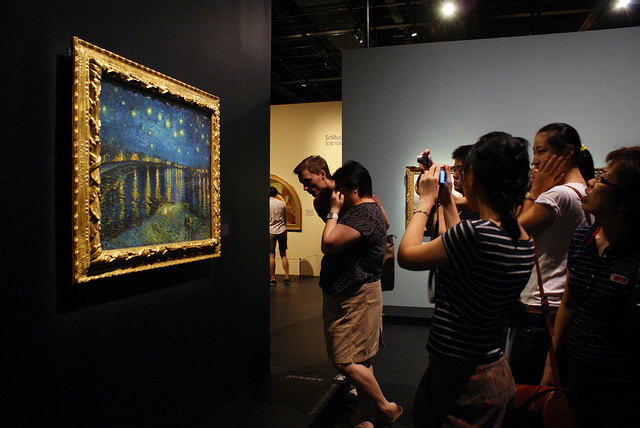The Starry Night Over The Rhone, 1888 by Vincent Van Gogh

Ever since Van Gogh arrived in Arles, he was constantly preoccupied with the representation of "night effects". In April 1888, he wrote to his brother Theo: "I need a starry night with cypresses or maybe above a field of ripe wheat."
In June, he confided to the painter Emile Bernard: "But when shall I ever paint the Starry Sky, this painting that keeps haunting me".
Starry Night Over the Rhone (September 1888) was one of three paintings made during the same month that incorporate the night sky and stars as fundamentally symbolic elements. He also painted
Cafe Terrace at Night, and a portrait of his friend Eugene Boch which was perhaps the most symbolic of the three.
Starry Night Over the Rhone was painted at a spot on the banks of river which was only a minute or two's walk from the The Yellow House on the Place Lamartine which Van Gogh was renting at the time.
The night sky and the effects of light at night provided the subject for some of his more famous paintings, including The Starry Night, the most famous Van Gogh night stars painting.
The challenge of painting at night intrigued Van Gogh. The vantage point he chose for "Starry Night Over the Rhone" allowed him to capture the reflections of the gas lighting in Arles across the glimmering blue water of the Rhone.
In the foreground, two lovers stroll by the banks of the river. Here his stars glow with a luminescence, shining from the dark, blue and velvety night sky. Dotted along the banks of the Rhone houses also radiate a light that reflects
in the water and adds to the mysterious atmosphere of the painting.

Depicting color was of great importance to Van Gogh. In letters to his brother, Theo van Gogh, he often described objects in his paintings in terms of color. His night paintings, including Starry Night Over the Rhone, emphasize the importance he placed in capturing the sparkling colors of the night sky and the artificial lighting that was new to this period. Here, everything lies spread beneath the sparkling tranquillity of the natural lights in the heavens. The glittering stars and wavy reflections in the water could scarcely cater better to Romantic tastes. In fact, this night scene was prompted by a genuinely moving experience of the endless darkness, an experience Van Gogh describes in a letter: "Once I went for a walk along the deserted shore at night. It was not cheerful, it was not sad - it was beautiful." This is the only place in his letters where he is so far carried away as to invoke Beauty so emphatically - reason enough to view his enthusiasm as something more profound than a mere momentary indulgence in aesthetics. Van Gogh was drawing upon all his Romantic resources, contesting the positivist attempt to see the stars, scientifically and banally, as mere objects in the realm of the known. A deep abhorrence of this attempt can be seen in the way his religious impulses surfaced once more:
It does me good to do something difficult. But it in no way changes the fact that I have an immense need for (should I use the word) religion; and then I go out at nightinto the open and paint the stars, and I always dream of such a picture with a group of lively friendly figures.




















